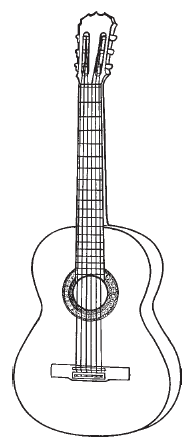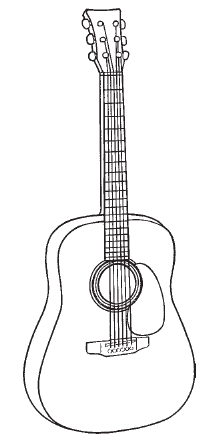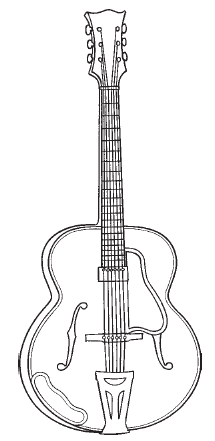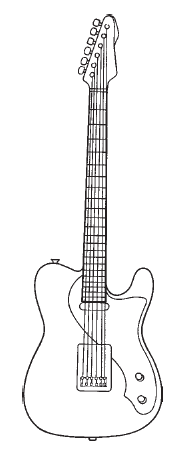Selecting a Guitar
This is the type of guitar that developed from the earliest forms of fourand
five-stringed instruments, reaching its final form in the early nineteenth century.
In addition to being the type of guitar used for the solo “classical” repertoire,
the Spanish or classical guitar is used for the accompaniment of folk songs, for
the songs and dances of Latin America, and for the flamenco music of Spain. Throughout
Europe it has long been the favorite accompaniment instrument for love songs and
serenades.

The nylon-strung Spanish or classical guitar.
Traditionally the sides and back of a flamenco guitar differ in that they’re
made of cypress wood, which is distinguishable by its yellow color and lighter weight,
but this is not always the case today because some of the great flamenco players
prefer hardwood.
Classical guitars usually have a slotted peg head and are strung with nylon strings.
Generally they are smaller than acoustic or electric instruments. The neck width
is greater than on acoustic or electric guitars to facilitate the intricate left-hand
work demanded in classical compositions.
Although the term “acoustic” really applies to any non-amplified guitar, it is
commonly used to describe the steel-strung guitar used in country, folk, and blues
styles. The steel strings give more volume than nylon, and also have a “brassier”
sound.
Acoustic guitar players can play with their fingers (as do classical players),
sometimes adding metal thumb and fingerpicks to enhance their sound. Others strum
across all the strings—or play complex melody lines—using a flatpick (also called
a plectrum).
The acoustic guitar has a beautiful rich sound in the hands of players like James
Taylor, John Renbourne, Leo Kottke, and many others. It works well as an accompaniment
instrument, and the best players also use it for solos and improvisations. However,
for intricate solo work it is somewhat harder to play than the Spanish guitar.

The acoustic guitar

The jazz guitar
This type of guitar is normally played with a plectrum, and represents a transition
from acoustic to electric guitar, because the guitar itself has some acoustic property
although nowadays it is normally amplified. Although a component of the rhythm section
of early jazz groups where its distinctive “chunk” sound would cut through and be
heard without amplification, this guitar was also used extensively for melody and
solo work, an example being the work of great players such as Django Reinhardt.
Distinguishing features include the violin-like f-holes which replace the circular
sound hole of the traditional guitar. Often jazz guitars are larger in size than
classical or acoustic guitars, and they usually have arched tops and backs, like
a violin. This is said to improve their sound projection. Pickups are now built
into the guitar, as are volume and tone controls.
The pioneering guitarist Les Paul was a technical as well as musical wizard.
He is famous for multitrack recorded performances, and his developments on the instrument
itself led to the extensive use of solidbody guitars with no innate acoustic resonance.
Used for chords and lead in contemporary rock groups, the solid-body guitar has
no sound until it is plugged into an amplifier. The electronic sound from pickups
is processed in inventive ways for special effects, including deliberate distortion.
The result is a new creation that has a fingerboard and strings but acoustically
shares little with the traditional guitar.

The solid-body electric guitar
|